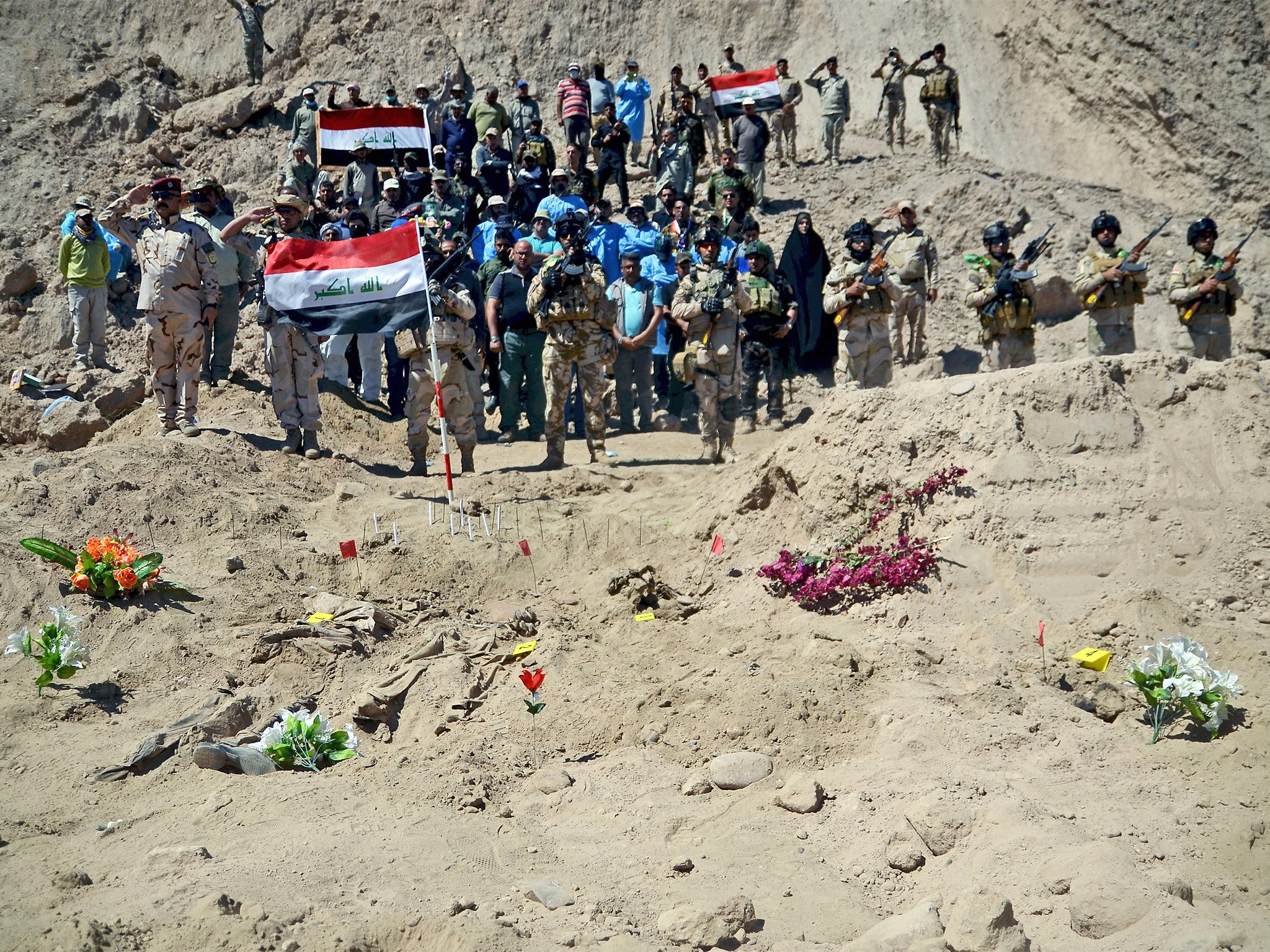Isis mass graves: Iraqi forensic teams recover remains of 1,700 military cadets slaughtered by militants near Tikrit
The soldiers were taken prisoner by the jihadists as they swept through northern and western Iraq during their blitzkrieg advance last year Warning: Some people may find the images below distressing

Mass graves containing the bodies of 1,700 Iraqi military cadets who were slaughtered by Isis fighters last June are being opened by Iraqi forensic teams who have gained access to them since the capture of the nearby city of Tikrit.
Blue-suited forensic teams were shown by Iraqi television digging in an open area, helped by bulldozers, as family members stood nearby.
As bodies were recovered, they were labelled with yellow tags while weeping soldiers and relatives lit candles and laid flowers alongside the covered remains. One clip showed unearthed skeletal remains wearing combat boots that were still intact. The Tikrit area is still insecure with some Isis fighters holding out in the north of the city and the forensic workers were guarded by Iraqi government soldiers as they began their work.
The unarmed cadets from the base at Camp Speicher were taken prisoner by Isis forces as they swept through northern and western Iraq during their blitzkrieg advance after the declaration of an “Islamic State” last year.
Videos showed the cadets forced to lie face down by a shallow trench, where they were sprayed with machine-gun bullets. Others were taken to the bank of the Tigris river and shot in the back of the head before being thrown into the water.
The massacre took place on 12 June last year and quickly became infamous because Isis made film of the atrocities, showing masked gunmen shooting, beheading and choking the young cadets. But the mass graves were previously inaccessible because Tikrit and the area around it was controlled by Isis until about a week ago, when a force of 25,000 Shia militiamen and soldiers recaptured it after a month-long siege.
Teams of Iraqi soldiers were assisting with digging at eight locations as they exhumed the first bodies. The graves are mostly inside a complex of palaces built by Saddam Hussein, the former Iraqi dictator, who came from Tikrit. It has never been explained why so many cadets stationed at the old American air base at Camp Speicher were ordered to change into civilian clothes and flee south to their homes in Baghdad and beyond – leaving them easy prey to rapidly advancing Isis forces.
By one account, the cadets were at first told by their captors that they were going to be part of a prisoner exchange. It was only later they were divided into batches to be more easily murdered.
Kamil Amin, from Iraq’s Human Rights Ministry, told reporters that 12 bodies had been exhumed on Monday and laboratory tests would be carried out to determine their DNA. Families of the victims have already given DNA samples so that the bodies of their relatives can be identified. Digging up all the bodies is expected to take months. Mr Amin said that “the work is continuing and we expect to discover more mass graves. We expect huge numbers of bodies to be unearthed”.
A purpose of the massacres carried out by Isis against Iraq’s Shia majority, aside from sectarian bloodlust, is to provoke a reaction against the Sunni community as a whole. This means that even those Sunni who do not like Isis are likely to be treated as Isis supporters by Shia soldiers, militia and police regardless of their real views. While Shia retaliation against Isis has so far been on nothing like the scale of the Camp Speicher massacre, Sunnis complain that they are being driven from their villages and some of them have been murdered or kidnapped at pro-government checkpoints.
Camp Speicher was not the only massacre carried out by Isis last year. The first mass killing came during its June offensive, outside Mosul, when they captured Badoosh prison and immediately split up Sunni and Shia prisoners, then killing 600 of the latter.
Other victims of mass killings since then include many members of the Albu Nimr tribe, which fought against Isis for almost a year in Anbar and other provinces before being overwhelmed because of a lack of ammunition. Tribal leaders say that since last October, 864 members have been killed at different times, their bodies being thrown down wells or taken out into the desert and burnt.
In pictures: Fight for Tikrit
Show all 16The systematic murder of Shias by Isis has mirrored that of al-Qaeda in Iraq since the first days of the US occupation in 2003. The preferred method before Isis became a powerful military force was to send suicide bombers to mosques, markets or pilgrimage sites where the explosion would cause maximum casualties.
The families of the Camp Speicher victims are enraged that their relatives should have been left defenceless as Isis closed in. Though there were many Iraqi soldiers in and around Tikrit, their commanders retreated without a fight.
Camp Speicher was the worst single massacre in Iraq since the US invasion of 2003. There was no previous atrocity on this scale since Saddam Hussein massacred as many as 10,000 Shia near Hilla in 1991, in the aftermath of the failed Shia uprising. As at Camp Speicher, victims were chosen because they were Shia, machine-gunned as they stood by deep ditches in which they were then buried by bulldozers. As at Camp Speicher a handful survived by pretending to be dead and then crawling away after the firing squads had departed.
* Isis has launched English-language radio news reports on its al-Bayan radio network. Promoted via Twitter, it accompanies Arabic and Russian bulletins already airing on the network.
Subscribe to Independent Premium to bookmark this article
Want to bookmark your favourite articles and stories to read or reference later? Start your Independent Premium subscription today.

Join our commenting forum
Join thought-provoking conversations, follow other Independent readers and see their replies